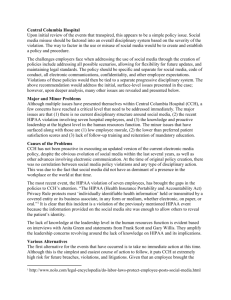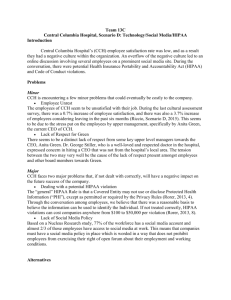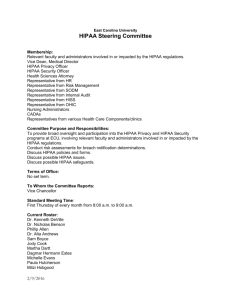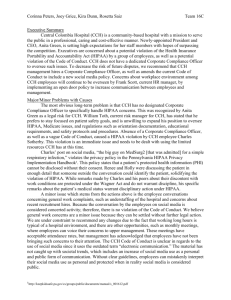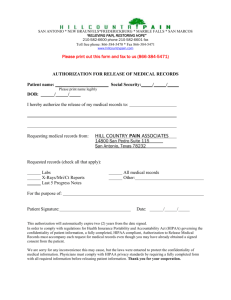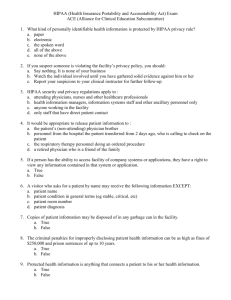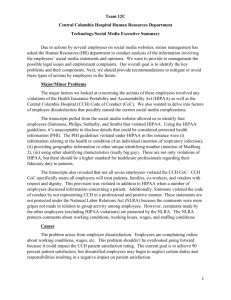Team 6C - Society for Human Resource Management
advertisement
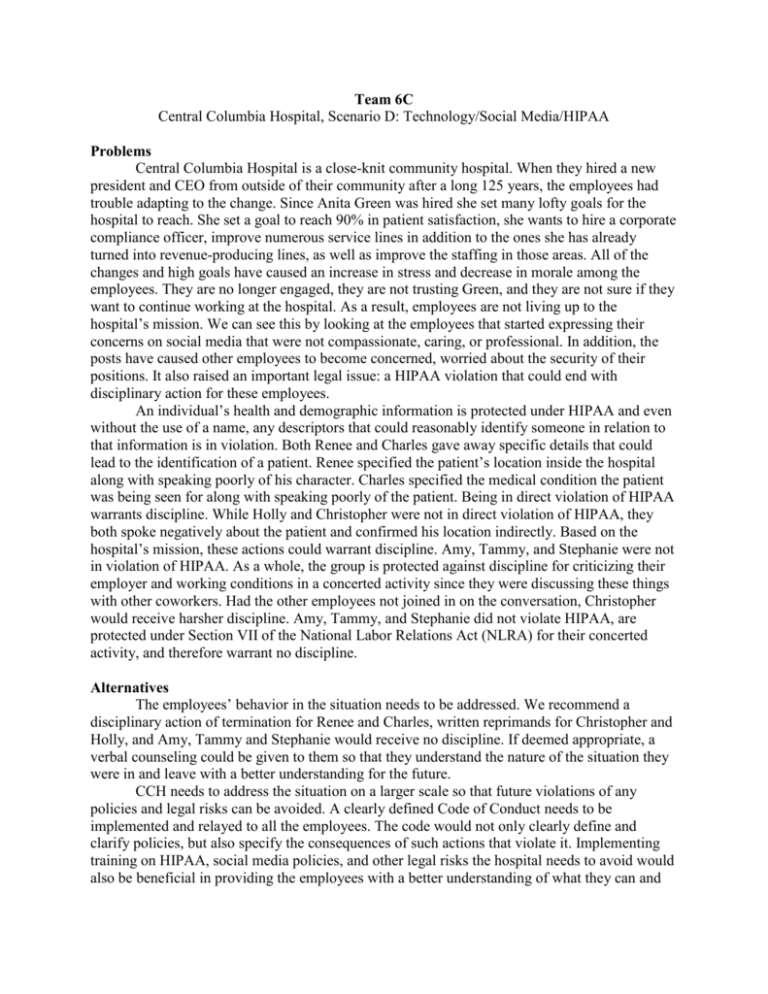
Team 6C Central Columbia Hospital, Scenario D: Technology/Social Media/HIPAA Problems Central Columbia Hospital is a close-knit community hospital. When they hired a new president and CEO from outside of their community after a long 125 years, the employees had trouble adapting to the change. Since Anita Green was hired she set many lofty goals for the hospital to reach. She set a goal to reach 90% in patient satisfaction, she wants to hire a corporate compliance officer, improve numerous service lines in addition to the ones she has already turned into revenue-producing lines, as well as improve the staffing in those areas. All of the changes and high goals have caused an increase in stress and decrease in morale among the employees. They are no longer engaged, they are not trusting Green, and they are not sure if they want to continue working at the hospital. As a result, employees are not living up to the hospital’s mission. We can see this by looking at the employees that started expressing their concerns on social media that were not compassionate, caring, or professional. In addition, the posts have caused other employees to become concerned, worried about the security of their positions. It also raised an important legal issue: a HIPAA violation that could end with disciplinary action for these employees. An individual’s health and demographic information is protected under HIPAA and even without the use of a name, any descriptors that could reasonably identify someone in relation to that information is in violation. Both Renee and Charles gave away specific details that could lead to the identification of a patient. Renee specified the patient’s location inside the hospital along with speaking poorly of his character. Charles specified the medical condition the patient was being seen for along with speaking poorly of the patient. Being in direct violation of HIPAA warrants discipline. While Holly and Christopher were not in direct violation of HIPAA, they both spoke negatively about the patient and confirmed his location indirectly. Based on the hospital’s mission, these actions could warrant discipline. Amy, Tammy, and Stephanie were not in violation of HIPAA. As a whole, the group is protected against discipline for criticizing their employer and working conditions in a concerted activity since they were discussing these things with other coworkers. Had the other employees not joined in on the conversation, Christopher would receive harsher discipline. Amy, Tammy, and Stephanie did not violate HIPAA, are protected under Section VII of the National Labor Relations Act (NLRA) for their concerted activity, and therefore warrant no discipline. Alternatives The employees’ behavior in the situation needs to be addressed. We recommend a disciplinary action of termination for Renee and Charles, written reprimands for Christopher and Holly, and Amy, Tammy and Stephanie would receive no discipline. If deemed appropriate, a verbal counseling could be given to them so that they understand the nature of the situation they were in and leave with a better understanding for the future. CCH needs to address the situation on a larger scale so that future violations of any policies and legal risks can be avoided. A clearly defined Code of Conduct needs to be implemented and relayed to all the employees. The code would not only clearly define and clarify policies, but also specify the consequences of such actions that violate it. Implementing training on HIPAA, social media policies, and other legal risks the hospital needs to avoid would also be beneficial in providing the employees with a better understanding of what they can and cannot say in different situations. It is important for all employees to be trained on these important issues annually as laws and technology can change over time. A way to address the stress and morale issues would be to provide resources for stress management the employees can utilize. Lastly, CCH needs to work on receiving more feedback from employees by having individual department meetings run by each department head. These steps will help the employees become more comfortable with changes being made at the hospital and create a better environment for them to voice their concerns. Their compliance and understanding would increase Green’s goals and it will help the hospital work on their results from the cultural assessment survey since the scores have continually decreased. Recommendation We recommend establishing a position for a corporate compliance officer. Hiring this employee will enable them to focus on “addressing HIPAA, Medicare issues, and regulations associated with the Department of Health and the Joint Commission's criteria” (Riccio, Steve). This employee will be able to work strategically with other executives in planning ahead to avoid all other possible compliance challenges. Moreover, this employee will have the ability to conduct annual HIPAA training for all employees. The corporate compliance officer will have the necessary knowledge and information to clarify the Code of Conduct and will be able to develop a formal social media policy. The formal social media policy will provide enough guidance for employees about the use of social media, since the current Code of Conduct does not. The policy will detail how CCH respects the right of employees using social media during nonworking hours, however social media may “cause certain risks and carries with it certain responsibilities” (Social Media Policy). These guidelines will include sections detailing what is considered social media, knowing and following the rules, being respectful, being honest and accurate, posting only appropriate and respectful content, using social media at work, how retaliation is prohibited, and media contacts. In addition, the social media policy will clearly state possible consequences that may result in disciplinary action up to and including termination. Lastly, the policy will mention that nothing in this policy is intended to interfere with the employees’ Section VII rights of the NLRA to communicate with each other regarding the terms or conditions of their employment (NLRB). This position needs to be approved and once that is done, Green can meet with Toth and Scott to discuss the hiring process for this employee and develop a job description. Since this employee could end up working with Human Resources and Risk Management, all three of them need to work together to start the search for these candidates, interview them, and come to a consensus on hiring the right person for the job. Hiring the corporate compliance officer is the first step CCH must complete to ensure the hospital is moving in a positive direction. Once this individual is hired and training for the social media policy and HIPAA issues are addressed, the hospital will be able to focus on improving their facility. This includes goals such as increasing employee satisfaction, wages, minimizing stress, and promoting a healthy work-life balance. Additionally, it will make CCH more proactive rather than reactive when dealing with company problems. Finally, making these necessary changes will aid CCH in executing their strategic goals and preserving and upholding the company’s mission to deliver health care services in a compassionate, caring, and cost effective manner while maintaining professional excellence. Works Cited 1. "Social Media Policy." SHRM Online - Society for Human Resource Management. N.p., n.d. Web. 09 Apr. 2015. 2. "Department of HealthJohn J. Dreyzehner, MD, MPH, Commissioner." HIPAA: Health Insurance Portability and Accountability Act. Web. 7 Apr. 2015. 3. "NLRB.gov." Protected Concerted Activity. N.p., n.d. Web. 09 Apr. 2015. 4. Riccio, Steve. Central Columbia Hospital. N.p.: Society for Human Resource Management, 2015. PDF. "Symptoms of Anxiety / Stress & Burnout Statistics." Symptoms of Anxiety / Stress & Burnout Statistics. Web. 7 Apr. 2015.
